Key Benefits of HRIS for Employers and Employees
Uncover how the benefits of Human Resource Management Information System boost productivity, ensure compliance, and enhance employee experience. Click for insights!
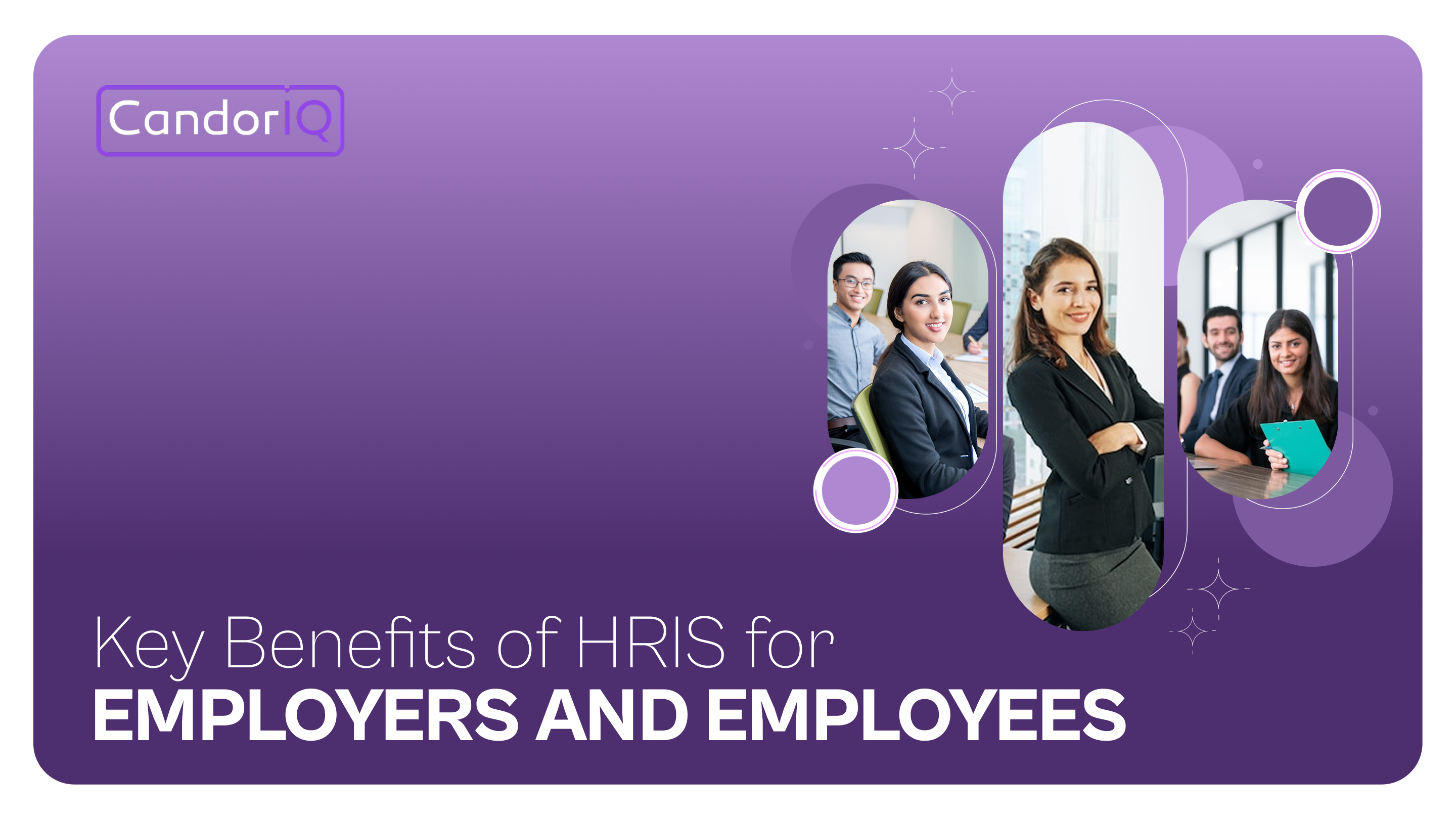
HR teams are under pressure to do more with less, and the data supports it. In 2024, Digital World Class HR organizations served 66% more employees per HR FTE at 39–44% lower labor cost than their peers, a gap driven by modern platforms and automation.
That momentum reflects a growing recognition that a Human Resource Information System (HRIS) isn’t just about automating tasks, it’s about building the infrastructure for fair pay, transparent policies, and informed decision-making.
An effective HRIS consolidates disparate processes, including compensation, workforce planning, performance management, and compliance, into a single platform that can evolve with the business. For employees, it simplifies access and empowers career ownership. For employers, it sharpens insights and reduces risks. Taken together, HRIS has become a key enabler of modern workforce strategy.
In this blog, we’ll explore the key benefits of a human resource information system for both employers and employees, highlighting its strategic impact across the organization.
Key Takeaways
- An HRIS centralizes all employee data and processes, providing a single source of truth for HR teams and managers.
- It transforms operational data into actionable insights, enabling smarter workforce planning, compliance, and compensation decisions.
- Employees benefit from self-service access, transparency in total rewards, and proactive support for life events and career development.
- Employers gain efficiency, reduced errors, governance, and analytics-driven decision-making that supports long-term strategy.
- Integrating an HRIS with platforms like CandorIQ elevates compensation, headcount, and workforce planning, turning data into strategic advantage.
What is HRIS?
A Human Resource Information System (HRIS) is a centralized software platform that manages all aspects of human resources, from employee data and payroll to benefits, performance, and compliance. It serves as the system of record for HR, providing a single source of truth for employee information while enabling HR teams to operate efficiently and strategically.
An HRIS typically consolidates multiple HR processes into one platform, allowing organizations to:
- Store and organize employee records, job data, and organizational hierarchies.
- Automate administrative tasks such as payroll, leave tracking, and benefits enrollment.
- Track performance, training, and development initiatives.
- Ensure compliance with labor laws and internal policies through accurate record-keeping.
Beyond administration, HRIS provides analytics and reporting capabilities that inform workforce planning, talent management, and decision-making. By integrating data and workflows, it allows HR teams to move from manual, fragmented processes to informed, data-driven strategies.
Suggested read: A Guide to Conducting an Effective HRIS Needs Analysis
Now that we understand the purpose and capabilities of an HRIS, let’s look under the hood to see how it captures, organizes, and routes employee data, turning it into actionable workflows and analytics.
How does HRIS work?
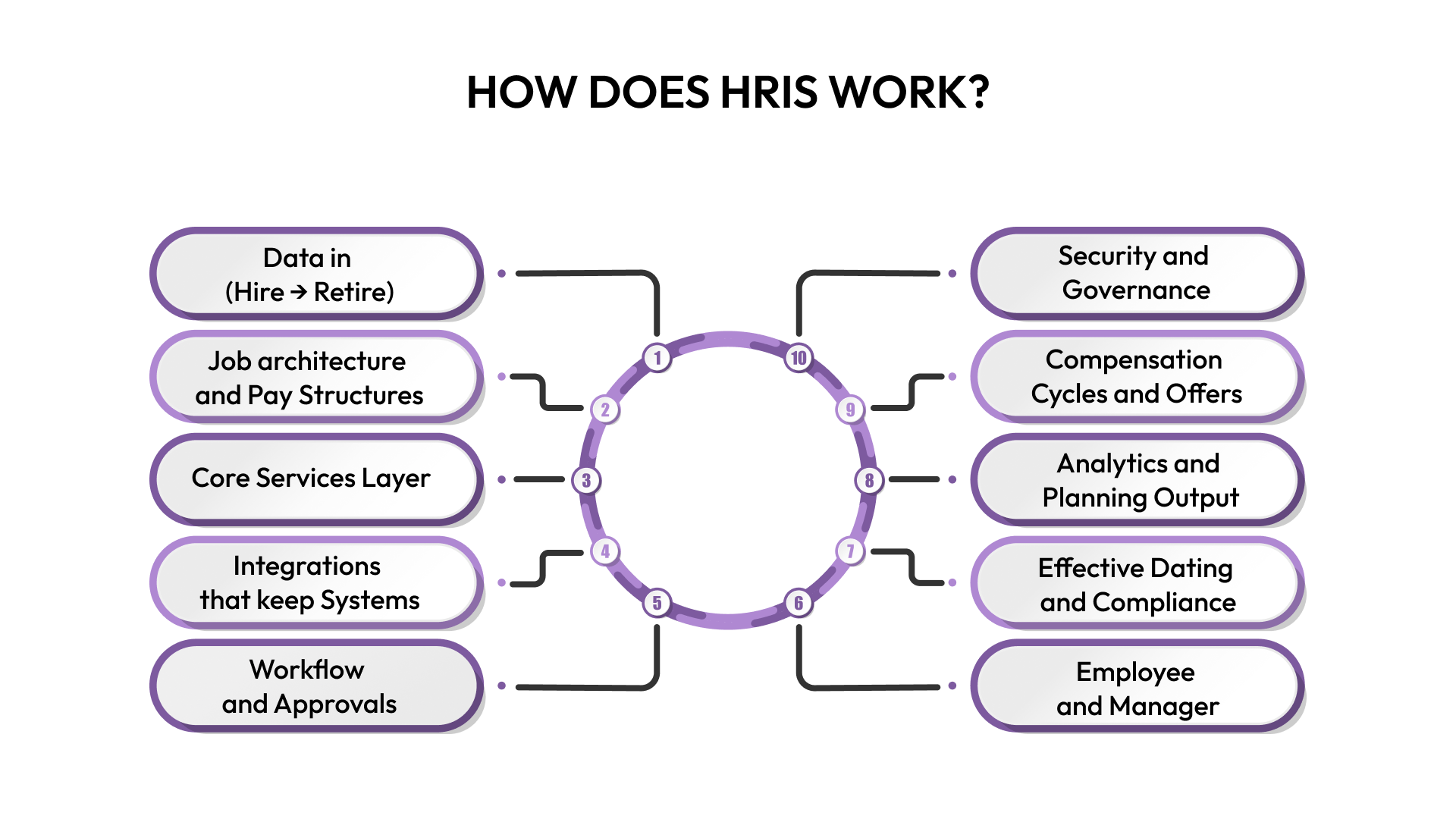
HRIS is the people-data backbone plus a workflow engine. It captures every employee event from hire to exit, routes the right tasks to the right people, and produces clean records for payroll, benefits, analytics, and audits. Here’s how it operates behind the scenes:
- Data in (hire → retire): New-hire details arrive from your ATS or are entered directly: identity, job, level, location, manager, comp elements. Over time, events like promotions, transfers, leaves, and exits update the same profile, creating a single timeline for each employee.
- Job architecture and pay structures: Roles, families, levels, and pay bands are configured once, then applied consistently across offers, promotions, and merit changes. This scaffolding prevents title sprawl, pay compression, and one-off exceptions.
- Core services layer: The platform standardizes codes (job, cost center, location), enforces validation rules (e.g., comp must fit band), and maintains role-based access so HR, managers, finance, and employees see only what they should. Every change creates an audit trail with who changed what and when.
- Integrations that keep systems in sync: Connectors exchange data with payroll, time & attendance, benefits administrators, identity/SSO, expense tools, and analytics warehouses. Approved changes in the HRIS (e.g., pay adjustments, new bank info) flow downstream automatically to eliminate re-entry and mismatches.
- Workflow and approvals: Common journeys, onboarding, pay changes, job changes, leave requests, offboarding, run as guided flows with dynamic approvers (manager → HRBP → finance, etc.). Rules can vary by country, entity, or job level. Notifications keep steps moving, and blockers are visible on a single track.
- Employee and manager self-service: People update addresses, tax forms, beneficiaries, and bank details; enroll in benefits; review payslips; request time off. Managers initiate offers, transfers, and merit recommendations, viewing team rosters, comp positions in band, and effective-dated histories.
- Effective dating and compliance: Changes are staged with future effective dates, so payroll and benefits pick them up in the correct cycle. Built-in checks support wage-hour rules, eligibility, document retention, and regional reporting; auditors can reconstruct any sequence of actions from the log.
- Analytics and planning output: Because all events live in one structured model, HRIS reports fuel headcount, turnover, diversity, and comp analytics. Data feeds into planning tools for scenarios, budgets, and pay-equity analysis—turning operational records into decision insight.
- Compensation cycles and offers: During cycle time, the HRIS provides current salaries, bands, eligibility, and performance flags to the comp tool. After approvals, the final numbers are updated in the employee record and payroll. For offers, the HRIS supplies job architecture and band rules so packages stay consistent.
- Security and governance: PII protection, encryption, granular permissions, and regional data controls keep information safe. Admins manage configuration through versioned policies so changes to rules or structures are traceable and reversible.
In practice: your HRIS becomes the authoritative source for people data, the conductor for HR tasks, and the publisher of clean, auditable outputs that payroll, benefits, finance, and planning tools rely on, including compensation and headcount platforms like CandorIQ.
.png)
Also read: Best HRIS Examples for 2025: Top Systems and Features
With the mechanics of HRIS in mind, the next step is to explore the real-world benefits employees experience, from increased visibility and autonomy to faster issue resolution and career guidance.
Key Benefits of HRIS for Employees
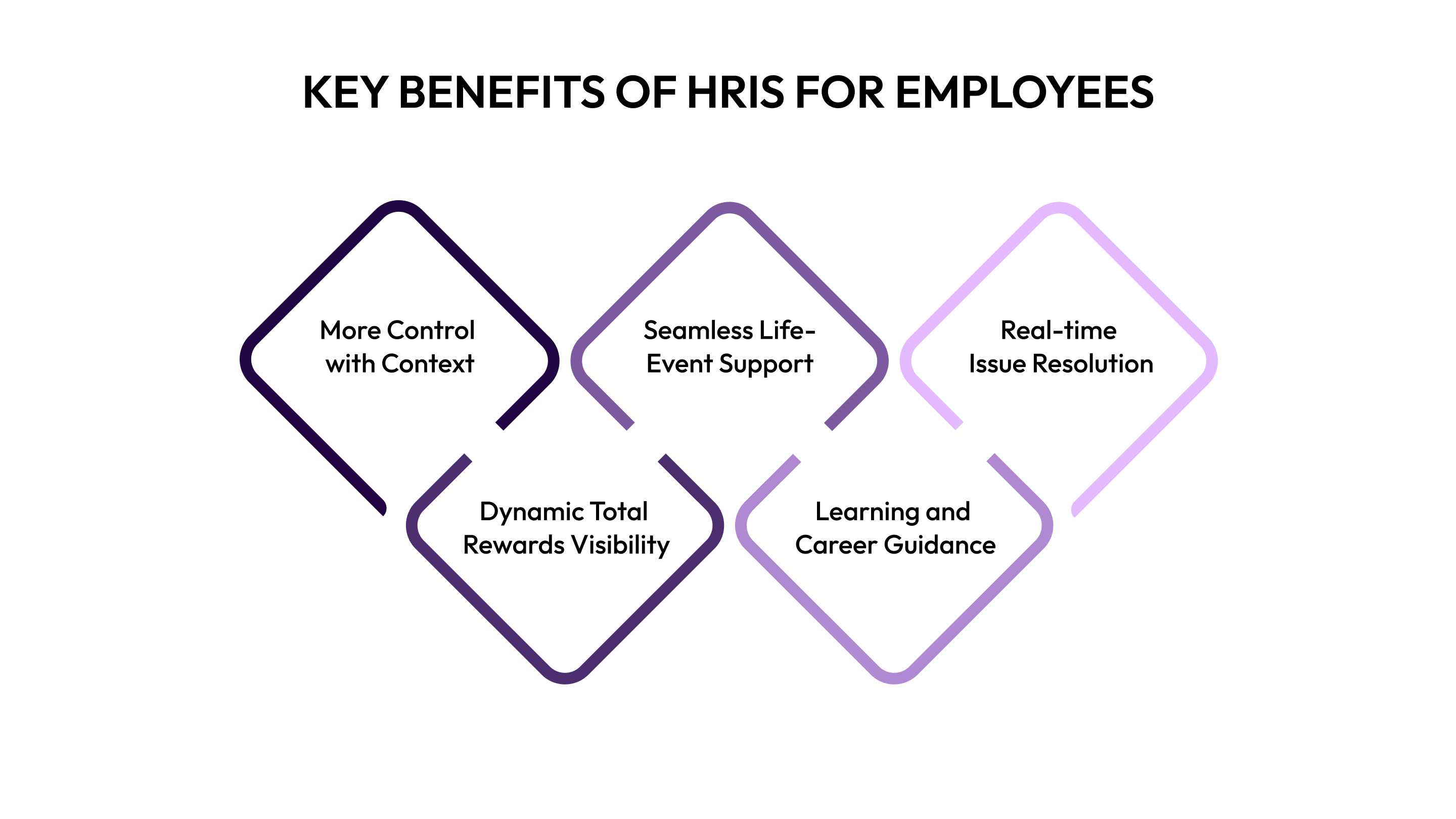
When employees talk about what makes their work experience easier, consistent access to accurate information usually tops the list. A well-implemented HRIS delivers exactly that: clarity, speed, and ownership of everyday HR interactions. Here are some of the most important ways employees benefit:
- More Control with Context: An advanced HRIS doesn’t just let employees update data; it shows impacts. For example, when someone changes their address or tax withholding, the system can show how that affects take-home pay, benefits eligibility, or deductions. This kind of “what-if” visibility helps employees make better decisions without surprise downstream effects.
- Dynamic Total Rewards Visibility: Rather than static pay slips or benefits summaries, a mature HRIS can model “future compensation”, showing how additional performance, promotion, or equity vesting will affect total rewards over time. When employees can see how their next raise or equity grant might play out, it strengthens performance linkage and engagement.
- Seamless Life-Event Support: The best HRIS solutions respond to life changes proactively. For example, when someone becomes a parent, gets married, or moves locations, the system can trigger benefit plan suggestions, tax reminders, or policy changes. This reduces friction and ensures the right benefits are in force when needed, not days later.
- Learning and Career Guidance in One Place: Instead of keeping performance, development, and learning systems separate, an HRIS can display recommended training, required certifications, gaps vs. role benchmarks, and career paths. It becomes a personalized roadmap, not just a status dashboard.
- Real-time Issue Resolution & Feedback Loops: Modern HRIS platforms can embed chatbots or guided workflows so that, when employees have questions or discrepancies, for example, a benefit not reflected or a time-off dispute, they can trigger an immediate path for resolution or escalation. That “in-system fix” replaces slow email chains and increases trust.
While employees enjoy transparency and self-service, employers gain powerful insights and control from the same platform. Understanding these advantages highlights how HRIS transforms workforce management from reactive administration to proactive strategy.
Key Benefits of HRIS for Employers
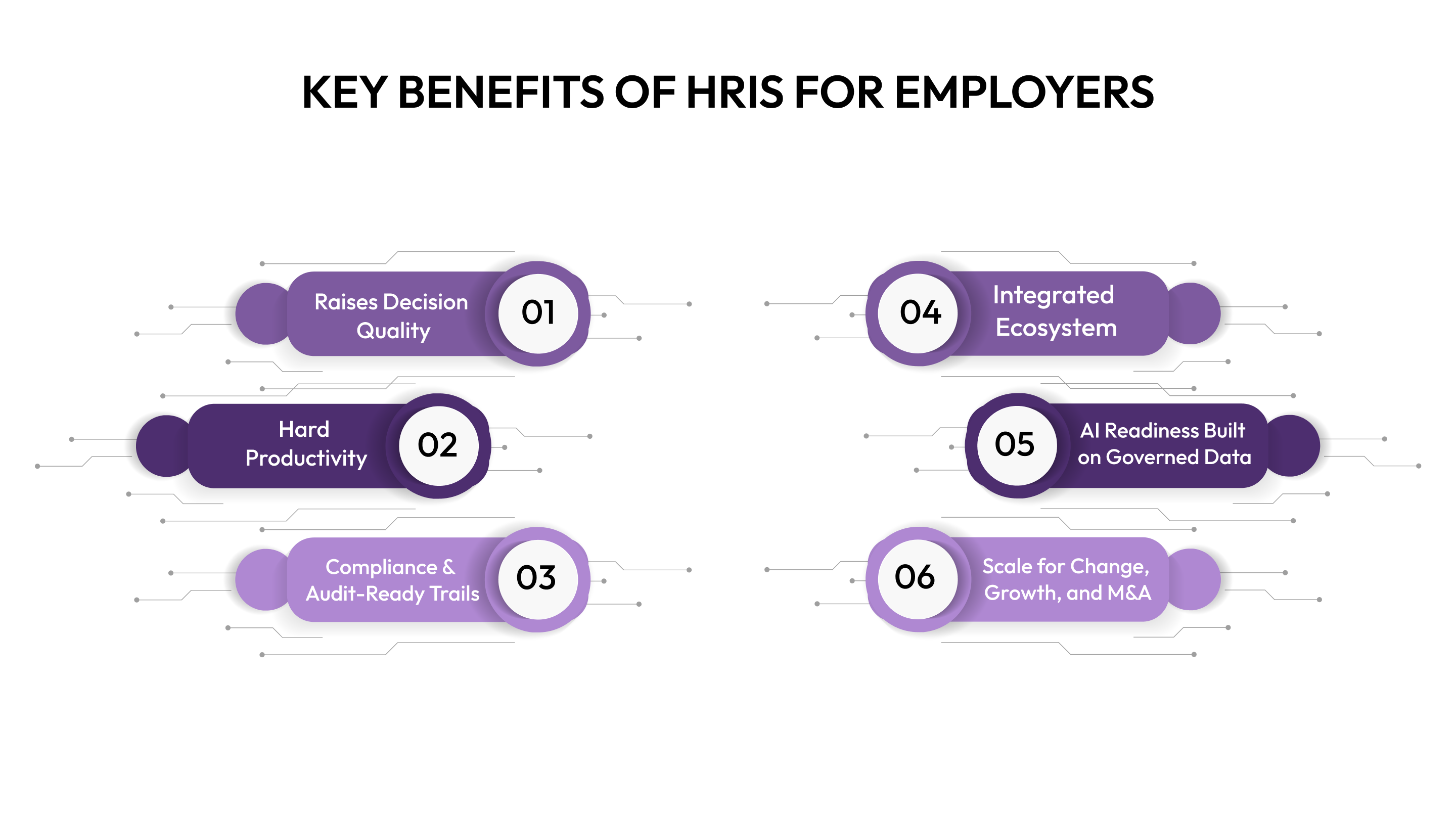
An HRIS gives employers a clearer picture of their workforce and the tools to manage it more effectively. Beyond automating routine tasks, it helps HR and leadership see patterns, make informed decisions, and respond faster to business needs.
- One source of truth that raises decision quality: A modern HRIS anchors jobs, pay bands, org structure, and history in a single model. That clean foundation is what powers credible analytics, pay-equity checks, and workforce planning, capabilities research firms now highlight as top HR tech priorities alongside AI.
- Hard productivity and cost gains: Top-performing HR organizations that invest in digital platforms support far more employees per HR FTE at materially lower cost, according to The Hackett Group’s 2024 benchmarks. Those gains show up at the process level too: independent ROI studies report onboarding cycle times dropping by 50–75% after digitization.
- Governance, compliance, and audit-ready trails: Role-based permissions, effective dating, and change logs make policies enforceable and audits faster. SHRM’s guidance on audits and manager self-service underscores the compliance upside when records, approvals, and eligibility rules live in the system rather than in email or spreadsheets.
- Integrated ecosystem that reduces reconciliation work: HRIS integrations push approved changes (job, pay, bank details, eligibility) to payroll, time, benefits, and data warehouses automatically, shrinking manual re-entry and the downstream corrections that follow. Vendors and analysts frame this “portfolio optimization” and ROI capture as a core 2024 imperative for HR leaders.
- Analytics and AI readiness built on governed data: When people data is structured and governed in the HRIS, HR can apply analytics and targeted AI use cases, skills insights, attrition risk signals, pay-compression flags, without creating new risk. Current research advises HR to prioritize high-value applications and work with legal and IT on accuracy and transparency.
- Scale for change, growth, and M&A: Consistent job architecture and global configuration let you absorb new entities, policies, and geographies without reinventing the operating model. Advisory perspectives for 2024 emphasize HR tech that supports boundary-spanning work and organization-wide transformation, not isolated transactions.
Knowing the benefits HRIS delivers, it becomes clear that organizations often need an added layer to manage compensation and workforce planning.
Bring your HRIS to life with CandorIQ
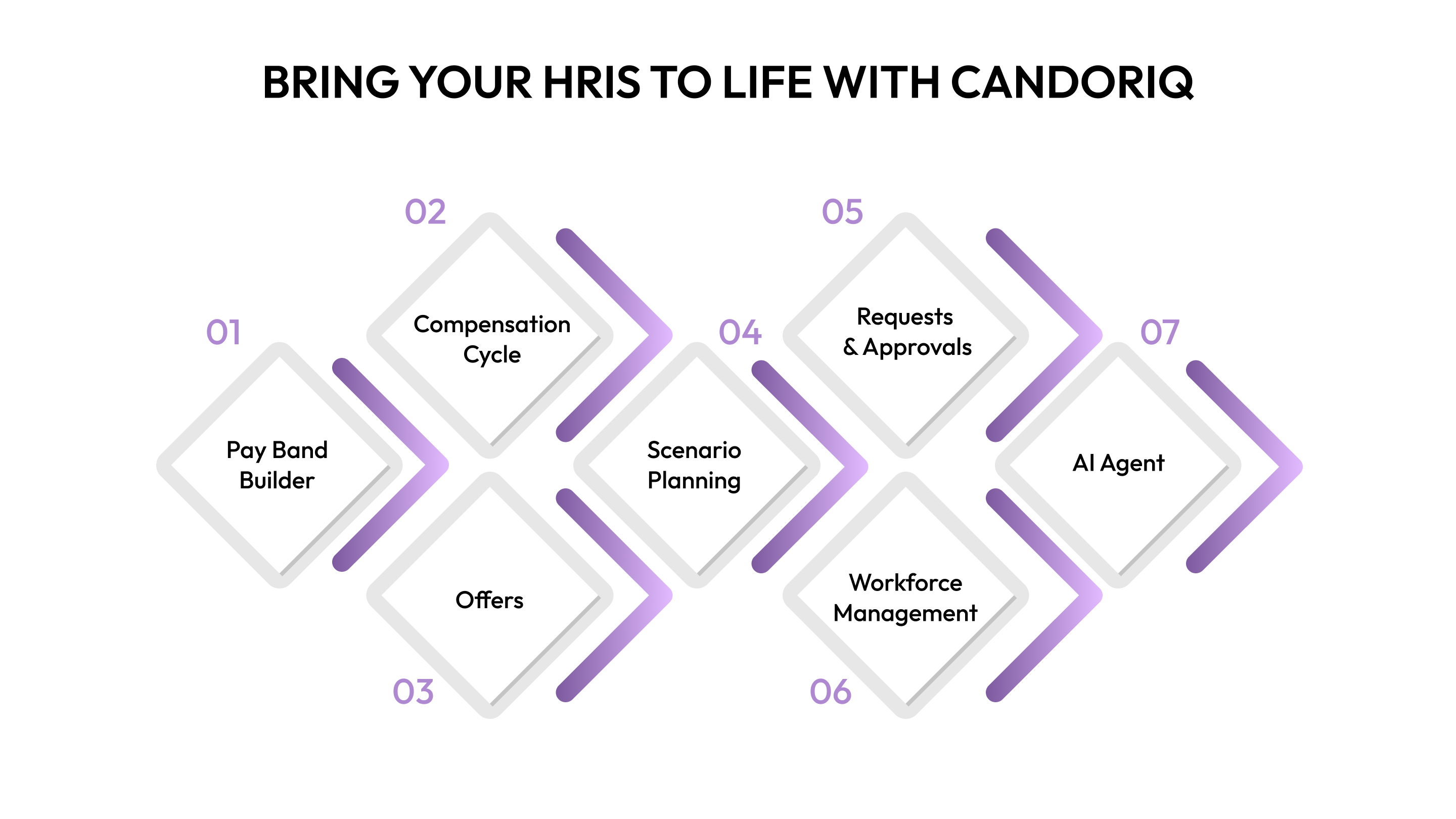
The HRIS is a solid system of record, but compensation cycles still spill into spreadsheets, headcount plans drift from budgets, and offer conversations lack clear total-rewards context. The gaps show up as pay-equity questions, slow approvals, and hard-to-answer “what will this hire do to burn?” moments.
CandorIQ is built to solve exactly this gap. It sits on top of your HRIS as the control center for compensation and workforce planning, giving you transparency, flexibility, and confidence in every people decision. It turns clean people data into decisions, so People, Finance, and leaders move in lockstep.
What you get:
- Compensation & Pay Band Builder: Geo-adjusted bands by level and job family, version control, access rules, and live distribution views.
- Compensation Cycle: Merit/bonus engine with budgets, guardrails, multi-step approvals, rationale logging, and in-platform collaboration (plus email/Slack nudges).
- Offers: Candidate-ready total compensation pages with salary, equity modeling, bonus, benefits, FAQs, and growth projections.
- Headcount Scenario Planning: Model future orgs, compare hiring paths, and see real-time budget and burn impact before committing.
- Headcount Requests & Approvals: Structured reqs with role details and rationale, dynamic routing by team/geo/level, ATS and finance sync.
- Workforce Management: Plan vs. actuals on roles, seats, attrition, promotions, and custom exec/FP&A/HRBP dashboards.
- AI Agent: Natural-language comp insights, gap analysis, forecasting, and spreadsheet-grade outputs powered by your historical data.
CandorIQ turns compensation and workforce planning into a strategic advantage, removing friction, driving equity, and aligning people strategy with business growth.
.png)
Conclusion
An HRIS should feel like infrastructure you can count on: solid records, clear approvals, fewer payroll surprises, and the kind of analytics leaders use to plan with confidence. When the foundation is right, HR stops firefighting and starts shaping pay, hiring, and growth with intent.
But while an HRIS provides the foundation, it often needs a specialized layer for compensation and headcount decisions. That’s where CandorIQ steps in. Our platform integrates seamlessly with your HRIS, turning static data into actionable strategies:
- Build geo-adjusted pay bands with live distribution views.
- Run compensation cycles with built-in approvals, guardrails, and budget tracking.
- Present candidates with clear, future-facing total compensation offers.
- Model headcount scenarios and budget impact before hiring.
- Equip leaders with dashboards that connect workforce planning to financial outcomes.
If you’re ready to connect your HRIS data to smarter, more equitable compensation and workforce decisions, book a demo with CandorIQ today.
FAQs
1) When is it time to move from spreadsheets to an HRIS?
Look for signals like growing payroll corrections, multi-location policies you can’t track consistently, managers asking for self-service, and audits taking longer every cycle. If HR spend is shifting to reconciliation instead of decisions, you’re overdue.
2) What should an HRIS “data exit plan” include before you sign a contract?
Confirm bulk export formats (full schema, effective-dated histories), secure transport options, API rate limits, and retention/deletion SLAs. Ask for a documented offboarding runbook so you can migrate cleanly without gaps in payroll, benefits, or compliance records.
3) How do high-maturity teams roll out HRIS changes without disrupting payroll?
They use a sandbox, run parallel tests for at least one pay cycle, version policies, and cut over with effective dates aligned to payroll close. A short “hypercare” window with clear escalation paths catches edge cases quickly.
4) How can an HRIS support deskless or field workforces?
Prioritize mobile-first experiences, multilingual UI, kiosk or QR time capture, low-bandwidth modes, and authentication that works without corporate laptops (e.g., SMS/Authenticator MFA).
5) Can an HRIS handle union rules and complex premium pay?
Yes, if it supports rule engines tied to job, location, shift, and agreement. Look for configurable differentials, accrual rules, seniority tracking, and auditable exception workflows.


